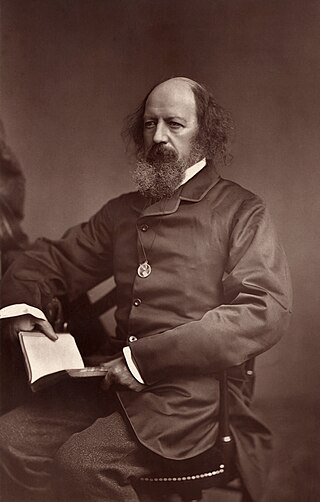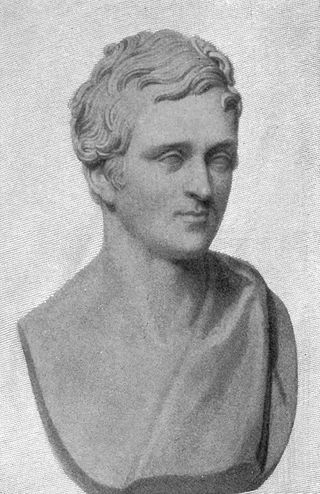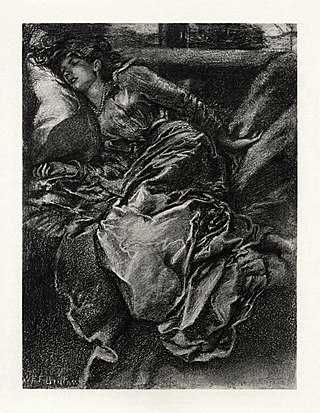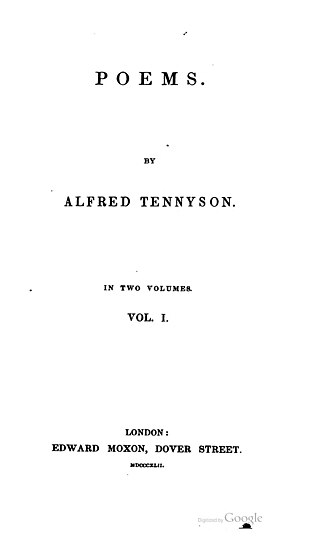A quatrain is a type of stanza, or a complete poem, consisting of four lines.

Alfred Tennyson, 1st Baron Tennyson,, was an English poet. He was the Poet Laureate during much of Queen Victoria's reign. In 1829, Tennyson was awarded the Chancellor's Gold Medal at Cambridge for one of his first pieces, "Timbuktu". He published his first solo collection of poems, Poems, Chiefly Lyrical, in 1830. "Claribel" and "Mariana", which remain some of Tennyson's most celebrated poems, were included in this volume. Although described by some critics as overly sentimental, his verse soon proved popular and brought Tennyson to the attention of well-known writers of the day, including Samuel Taylor Coleridge. Tennyson's early poetry, with its medievalism and powerful visual imagery, was a major influence on the Pre-Raphaelite Brotherhood.
This article contains information about the literary events and publications of 1850.
This article contains information about the literary events and publications of 1833.

Edward Moxon was a British poet and publisher, significant in Victorian literature.

Arthur Henry Hallam was an English poet, best known as the subject of a major work, In Memoriam, by his close friend and fellow poet Alfred Tennyson. Hallam has been described as the jeune homme fatal of his generation.
Emilia Tennyson (1811–1887), known simply as Emily within her family, was a younger sister of Alfred, Lord Tennyson, and the fiancée of Arthur Henry Hallam, for whom Tennyson's poem, In Memoriam A.H.H., was written. Emilia met Hallam through her brother, and they became engaged in 1832.

"Ulysses" is a poem in blank verse by the Victorian poet Alfred, Lord Tennyson (1809–1892), written in 1833 and published in 1842 in his well-received second volume of poetry. An oft-quoted poem, it is a popular example of the dramatic monologue. Facing old age, mythical hero Ulysses describes his discontent and restlessness upon returning to his kingdom, Ithaca, after his far-ranging travels. Despite his reunion with his wife Penelope and his son Telemachus, Ulysses yearns to explore again.
— From Cantos 27 and 56, In Memoriam A.H.H., by Alfred Tennyson, published this year
Nationality words link to articles with information on the nation's poetry or literature.
Nationality words link to articles with information on the nation's poetry or literature.
"Ring Out, Wild Bells" is a poem by Alfred, Lord Tennyson. Published in 1850, the year he was appointed Poet Laureate, it forms part of In Memoriam, Tennyson's elegy to Arthur Henry Hallam, his sister's fiancé who died at the age of 22.

"The Two Voices" is a poem written by future Poet Laureate of the United Kingdom Alfred, Lord Tennyson between 1833 and 1834. It was included in his 1842 collection of Poems. Tennyson wrote the poem, titled "Thoughts of a Suicide" in manuscript, after the death of his friend Arthur Henry Hallam in 1833. The poem was autobiographical.

"Tithonus" is a poem by the Victorian poet Alfred, Lord Tennyson (1809–92), originally written in 1833 as "Tithon" and completed in 1859. It first appeared in the February edition of the Cornhill Magazine in 1860. Faced with old age, Tithonus, weary of his immortality, yearns for death. The poem is a dramatic monologue with Tithonus addressing his consort Eos, the goddess of the dawn.

The Princess is a serio-comic blank verse narrative poem, written by Alfred Tennyson, published in 1847. Tennyson was Poet Laureate of the United Kingdom from 1850 to 1892 and remains one of the most popular English poets.

The Church of St Andrew in Clevedon, Somerset, England. Parts of the original 12th-century church remain with 14th- and 15th-century additions. It is on a hill overlooking the Bristol Channel, and has been designated as a Grade I listed building.

"The Day-Dream" is a poem written by Alfred Tennyson that was published in 1842. It was an expanded version of his 1830 poem "The Sleeping Beauty". It was further altered in 1848 for a dramatic performance for a private gathering with Tennyson starring as the Prince. "The Day-Dream" discusses the nature of sleeping and of dreaming, especially in relation to individuals that would want to escape from reality. The poem also compares the act of poetry with dreaming and asserts that the two are the same.

"Sir Galahad" is a poem written by Alfred Tennyson, 1st Baron Tennyson, and published in his 1842 collection of poetry. It is one of his many poems that deal with the legend of King Arthur, and describes Galahad experiencing a vision of the Holy Grail. The subject of the poem was later included in "The Holy Grail" section of Tennyson's Idylls of the King, but the latter version depicts Galahad as a pious individual who is grimly determined to fulfill his destiny. Sir Galahad, in contrast, depicts Galahad as proud, and has almost cheerful undertones.

Poems, by Alfred Tennyson, was a two-volume 1842 collection in which new poems and reworked older ones were printed in separate volumes. It includes some of Tennyson's finest and best-loved poems, such as Mariana, The Lady of Shalott, The Palace of Art, The Lotos Eaters, Ulysses, Locksley Hall, The Two Voices, Sir Galahad, and Break, Break, Break. It helped to establish his reputation as one of the greatest poets of his time.













